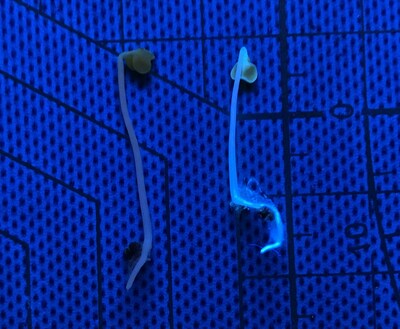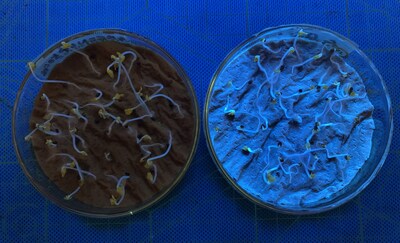KAWANISHI-CITY, Japan, Feb. 15, 2023 /PRNewswire/ — Green Science Alliance developed fluorescent fertilizer with their quantum dot. They succeeded in growing fluorescent plants (Japanese Musterd Greens) from seeds using this fluorescent quantum dot nano fertilizer (QDNF). The global food crisis is becoming increasingly severe, and food prices are escalating. Not only foods but also fertilizers are an indispensable resource, and fertilizer prices are also escalating. Fertilizers comprise three key elements: nitrogen, phosphorus, and potassium.
The particle size of the currently used commercial fertilizers (solid fertilizers) needs to be small by bacteria decomposition in the soil before they can be absorbed by plants; otherwise, the fertilizers can drained out of the soil by rain, for example. In addition, a small amount of fertilizers have been reported to evaporate into the atmosphere. Few studies have reported that at least half of the fertilizers applied on the soil are wasted due to these aforementioned reasons.
Recently, a new type of fertilizer called “nano fertilizer” has been developed. When the particle size of the fertilizers is in the range of nanometers, the fertilizers can run through the path between plant cells; hence, the fertilizers can be absorbed in plants without the assistance of bacteria decomposition. Therefore, by the application of nano fertilizers, a majority of the fertilizers can be efficiently utilized, resulting in agricultural crops in higher yields compared to the amount of crops obtained using a commercial solid fertilizer.
Nano fertilizers can be absorbed in plants not only from the soil but also from leaves; hence, farmers apply nano fertilizers on plant leaves by simply spraying from above using a drone, which is possible when liquid fertilizers are used. Nevertheless, nano fertilizers exhibit better advantages. For example, nano fertilizers contain not only fertilizer components but also components of the pesticides, herbicides, and metals required for plant growth within nanoparticles or on the surface. Furthermore, some studies have reported that recombinant genes can be introduced into plants by using nano fertilizers as the gene carrier.
Quantum dots are super tiny materials (0.5–9 nm) with optical properties that follow the rules of quantum chemistry and quantum mechanics. These quantum dots are called “artificial atoms or artificial molecules” because each quantum dot comprises several dozen to thousand number of atoms or molecules. At this size range, the energy levels of electrons are no longer continuous and are separated due to the physical phenomenon known as the quantum confinement effect. Under this condition, the wavelength of emission light depends on the size of the quantum dot.
This time, Dr. Ryohei Mori has synthesized graphene quantum dots with chemical composition comprising the three key fertilizer elements: nitrogen, phosphorus, and potassium. In addition, he has used raw materials that are safe for human health and the environment, although this type of new material needs to be tested in terms of human health and ecological impacts for actual applications. When this quantum dot fertilizer is applied to the seeds of the Japanese Musterd Greens plants, they grow as much as they would with the use of a commercial liquid fertilizer. In addition, the as-grown plant exhibits fluorescence under ultraviolet-light and blue light irradiation, indicating that QDNF is absorbed in plant bodies during their growth.
To the best of our knowledge, there has been no successful report of growing actual plants (not animal or fungus) that emit fluorescence, which is clearly recognized by the naked eye. (Some studies have reported luminescent plants by artificially embedding nanoparticles or luminescent bacteria into plant bodies. In addition, some rare examples exist; for example, some plants, such as Mirabilis, emit fluorescent light.)
QDNF exhibits the following advantages over commercial fertilizers (including solid and liquid fertilizers).
- QDNF can function as plant stress sensors because the fluorescent light of some quantum dots disappears when they react with substances, such as H2O2, Ca2+, and NO, which are generated by stress in plants body. If possible, farmers can take adequate measures at the early stage of stress to save agricultural crops.
- QDNF can be a pesticide, herbicide, and an antibacterial residue sensor as these substances are harmful to the ecological environment and human health, because the fluorescence of some quantum dots disappears when they react with pesticide residues, such as diazinon, glyphosate, and semicarbazide, triazine, and aromatic pesticides, as well as heavy toxic metals.
- QDNF can be a metal (e.g., Zn, Cu, and Fe) carrier into plants, which is indispensable for plants.
- Quantum dots on plant leaves can convert solar light into the light with a wavelength more favorable for plant growth.
- Commercial fertilizers spread on soils will serve as nutrition for not only target crops but also weeds. In this regard, QDNF is more favorable because they can be absorbed from leaves.
- Gene mutation procedures, such as the particle gun method, may damage the plant itself. QDNF can carry the required recombinant gene into plants without damaging the plants and can even track recombinant gene because of illumination.
Dr. Ryohei Mori will further challenge himself and his team to develop quantum dot nano fertilizer products based on the above advantages to contribute to the food industry.
Media Contact:
Ryohei Mori
81-72-7598501
353524@email4pr.com
SOURCE Green Science Alliance Co., Ltd


